A pot you are supposed to scream into. An Ikea vase recast in porcelain and returned to the store, never to be seen again. A sculpture of a fox with a silver tray that is actually a time capsule not to be opened for a 100 years, lest its financial and cultural value drops to zero.
These are just some of the works created by Tehran-raised, Vancouver-based artist Babak Golkar. And they are becoming better-known worldwide.
Right now, as Frieze Week kicks off in London, the Return Project series—for which Golkar purchases objects from mass-market chains, alters them and then returns them, only retaining photographs and an object made from offcuts—is being featured in the city’s Edel Assanti gallery, providing some side-eye commentary on fair frenzy.
Also recently opened in at Sabrina Amrani in Madrid are selections from Golkar’s Time Capsules series. Each piece in this series appears, at first glance, as a sculpture. But inside, these sculptures house concealed objects. The catch: anyone purchasing one of these works must sign a contract stating they will not allow the sculpture/capsule to be opened for another 100 years. If the work is opened before 2116, the financial and cultural value of the work drops to zero.
In January, Golkar will be doing a residency at the Davidoff Art Initiative in the Dominican Republic, bringing his ideas to even more audiences.
Here, over the phone from his home in North Vancouver, Golkar talks about migration, frustration and other factors driving his practice.
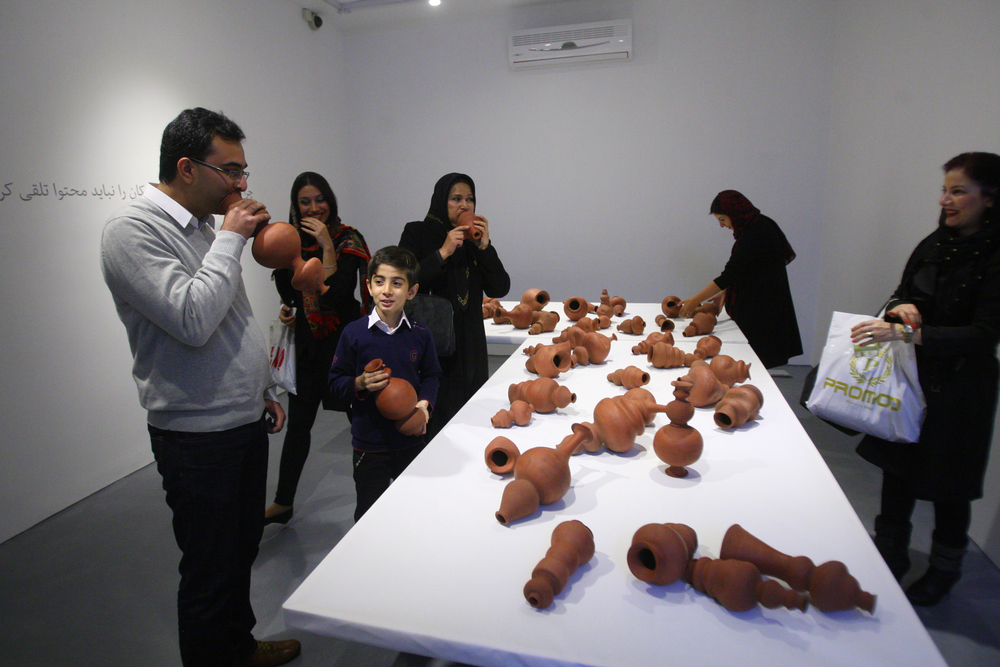 Babak Golkar’s Scream Pots were part of his exhibition at Ab-Anbar gallery in Tehran in 2014, and visitors were free to use them as desired. Photo courtesy of the artist.
Babak Golkar’s Scream Pots were part of his exhibition at Ab-Anbar gallery in Tehran in 2014, and visitors were free to use them as desired. Photo courtesy of the artist.
Leah Sandals: Why did you move from Tehran to Vancouver in your late teens?
Babak Golkar: I moved from Tehran to Calgary, in fact, in the mid-90s.
The reason I moved there is because we had some relatives, so it was a logical choice. But soon after, I realized I couldn’t do anything there.
I couldn’t speak English. I was driving a delivery van, which didn’t require much language, in a way. So I would pick up donuts and drop them off to every 7-11 in Calgary from midnight to 5 a.m. And that was a very harsh reality check, because I was faced with several instances of a very vivid sort of racism.
My parents were going to move about 10 months after me, and I said, “Don’t come to Calgary—maybe go somewhere more moderate in terms of weather and in terms of culture a little bit.”
Back then, Vancouver was much more diverse than Calgary. So I made a trip here. And then I moved to Seattle to do studies for about a year and a half, and then I moved back.
So I guess convenience and also family support and sense of community is why I moved. Now, I have a family of my own here in Vancouver—my wife and two-year-old daughter.
LS: How did you start making art?
BG: I tried a whole bunch of stuff—I tried engineering and architecture and design, and kind of stumbled upon ceramics and pottery. Then I dropped everything and became a full-time ceramics shopkeeper, in a way. I liked it so much.
I applied to Emily Carr and didn’t get in the first time, and then I took a couple of courses part-time and got in on the next try, majoring in ceramics.
In third year I was introduced to conceptual art through a lecture one of the professors gave. He posted a photograph of Duchamp’s Fountain and said, “This is one of the most pivotal pieces of 20th-century art, and it is made out of porcelain—but no one talks about the medium.”
With that lecture, everything changed for me. What I didn’t like about ceramics were the historical boundaries that were there on function and surface. I had a lot of respect for the processes of ceramics, but I wasn’t so interested in function and surface decoration. I had to give it a break—like 10 years or 12 years—before I could come back to it.
So my last year of undergrad was all sort of experimenting with a performative practice, with getting the audience to perform around objects, or getting the work to perform.
Then, when I did my MFA at the University of British Columbia, it was two years of researching how to approach performative practices, and also producing drawings and installation works.
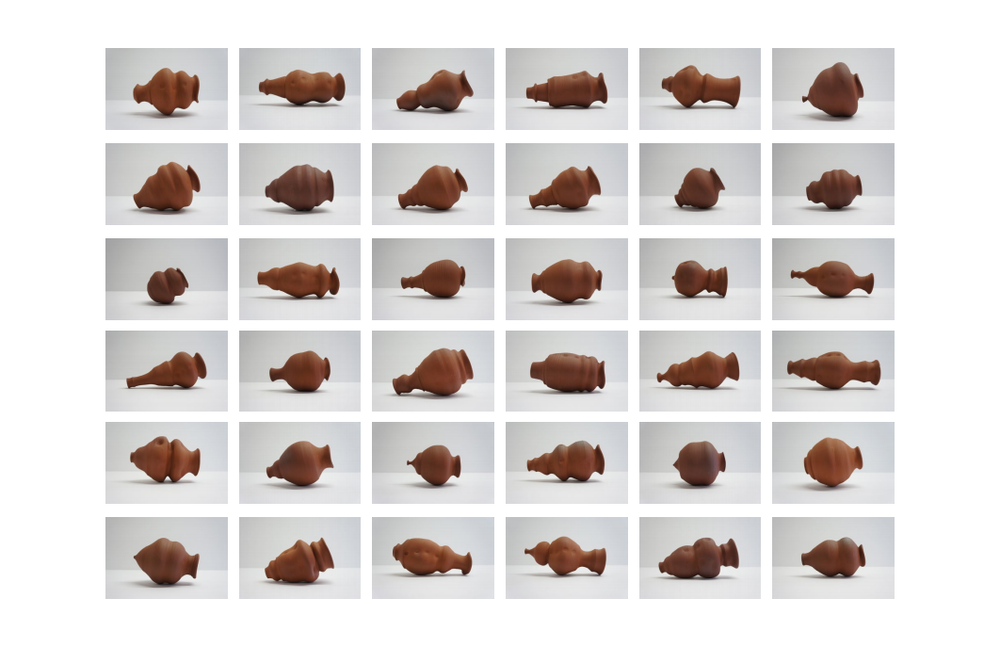 An assortment of Scream Pots by Babak Golkar.
An assortment of Scream Pots by Babak Golkar.
LS: One of the works you are now known for is your “scream pots”—vessels that visitors are invited to scream into. In 2014, you did a large public installation of these in Vancouver, too. Can you tell me more about these objects and what you learned from putting them into public space?
BG: When I went back to ceramics, I did a series of sculptural objects called Scream Pots. They didn’t have to have their surfaces decorated—they are undecorated mid-range fired terracotta. And the function is for any of us to hold them up to our mouths and scream—the function is to silence you.
Later, the six-foot-long ones were commissioned by the Vancouver Art Gallery for Time to Let Go.
For the public piece, I wanted to frame it as a platform that was very inclusive, and may not feel like art, in a way. And I was overwhelmed by the response—not just from people who knew what this whole thing was about, but response from people randomly.
Then we did another iteration of them in Iran, as part of the largest solo exhibition I had to date, in 2014.
In the artist talk I gave, they kept pressuring me to give a political answer—like, “These are for people of Iran who are frustrated politically to scream into.”
The thing is, sometimes you want to scream, and to do that in civilized society you would be judged completely—but this platform allows you to do that and there is no judgment.
After that, I realized that the work allows you to bring in whatever you want, or whatever background you want, and that’s exactly what it gives back to you. So if you are a frustrated parent, you can bring that into it. If you are a political activist, you can bring that.
In fact, when we opened the public installation in Vancouver, it was tax time, and the curator got messages from accountants saying they appreciated the piece.
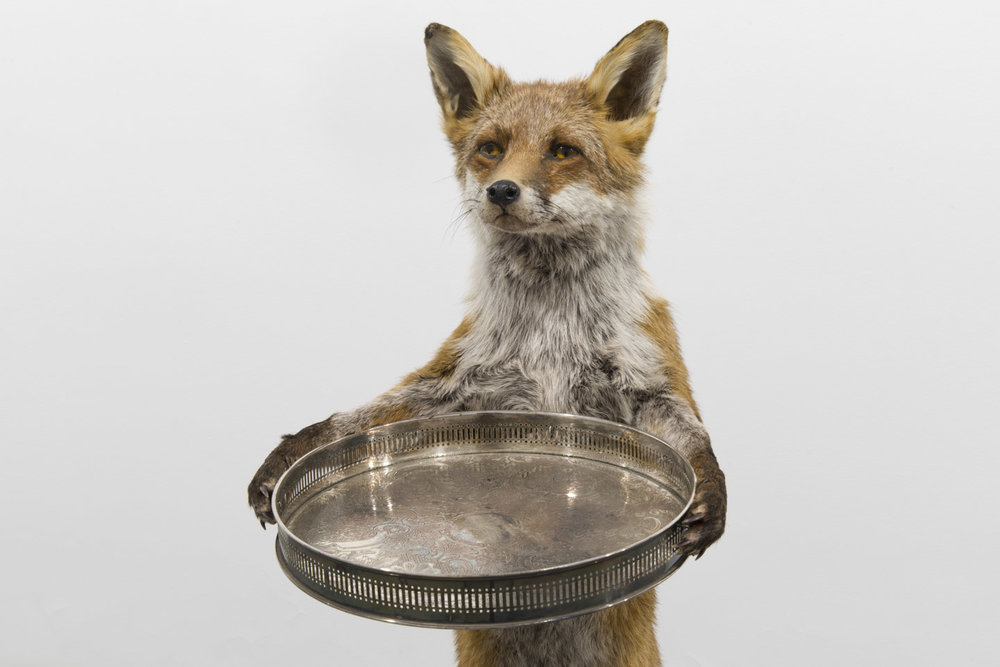 For his series Time Capsules, Babak Golkar created sculptures that also contain concealed objects. The catch: if the sculpture is opened before 2116, the value of the work reverts to zero. This specific work is called The Fox, The Nut and the Banker’s Hand. Courtesy of the artist.
For his series Time Capsules, Babak Golkar created sculptures that also contain concealed objects. The catch: if the sculpture is opened before 2116, the value of the work reverts to zero. This specific work is called The Fox, The Nut and the Banker’s Hand. Courtesy of the artist.
LS: What would you say drives your practice right now?
BG: I’m a very frustrated guy; I guess frustration is the drive for me. And I don’t think there is a shortage of anything that causes us anxiety and frustration nowadays.
LS: If frustration is what drives your practice, what I see in your recent work is some frustration around ideas of value and time. Can you talk a bit about your current exhibition of Time Capsules in Spain in this respect—especially around how the value of each artwork will drop to zero if someone opens it before 2116?
BG: The title of the show in Spain is “In No Particular Hurry.” It comes out of this frustration that we have no time to do anything towards self-reflection—we develop, but we don’t sit back and examine that.
I see that as not just a condition of our time, but also a condition of modernity in general. What we consider the beginning of modernity is the engine, and these engines are set up to be non-stop—a good engine would work non-stop and forever.
I’m also interested in certain kinds of delays—you know, like, some 95-year-old man dies in the outskirts of Paris and the grandkids go to the garage and they find five Picassos, and it turns out the guy who died was the driver of Picasso. And the next thing you know Sotheby’s is calling, and Christie’s is calling, and all this economy is happening out of this bit of news.
With the time capsules, I am interested in delaying the art. And I am also interested in this basic human characteristic—as soon as I tell someone, “You can’t open it for 100 years,” I can see their frustration. I am interested in those kinds of frictions and tensions.
The time capsules actually bracket 200 years—the past 100 years were the source for the subjects I came up with. And in 100 years from now, those sculptures will have to be destroyed for the time capsules to be opened.
Another layer to the time capsules is this idea of “Who is an art gatekeeper?” The traditional idea of museums and patronage has practically disappeared, and I’m interested in going back to those ideas. Whoever commits to these 100 years has to be a serious collector or curator. There is frustration there, but also respect.
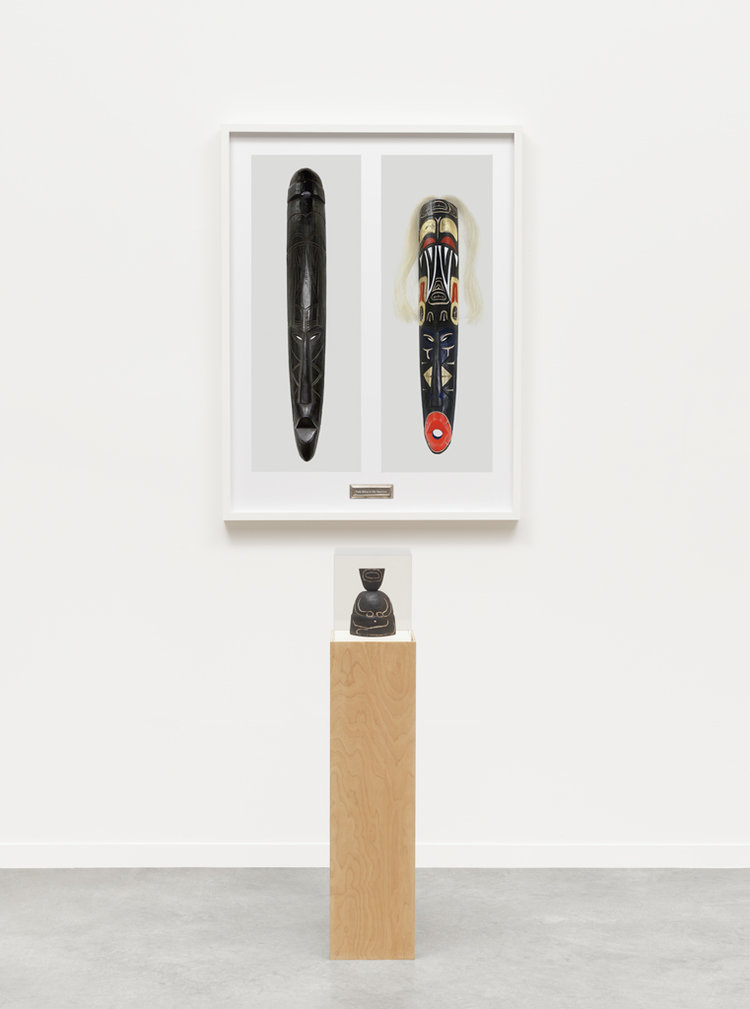 For The Return Project, Babak Golkar purchased objects from Ikea and other mass-market stores, then altered them while keeping tags intact. A before and after photo was taken before the object was returned to the store, and Golkar also made a new sculpture from hte offcuts. This specific work is called From Africa to the Americas (including To Cubism) (2014). Photo: Trevor Mills, Vancouver Art Gallery. Courtesy the artist.
For The Return Project, Babak Golkar purchased objects from Ikea and other mass-market stores, then altered them while keeping tags intact. A before and after photo was taken before the object was returned to the store, and Golkar also made a new sculpture from hte offcuts. This specific work is called From Africa to the Americas (including To Cubism) (2014). Photo: Trevor Mills, Vancouver Art Gallery. Courtesy the artist.
LS: The Return Project—currently on display in London, England—also plays with ideas of value. For this, you make alter an item purchased at a store, photograph the before and after, then return the altered item to the store where you got it, and also make a sculpture out of the offcuts. Why do you do this?
BG: In The Return Project I was interested in the disappearance of the art object. The documentation is all that is left—the objects are gone back into Walmart or Ikea, or other stores in which they originate.
In 2002, in my third year of undergrad, I was learning how to make ceramic moulds. And I came across this Ikea vase which was made out of really shitty material. I was learning how to work with porcelain and fine china at the time, so I made a mould of that Ikea vase and I cast it in really fine porcelain, and tinted it with a bit of a pink stain. And I returned that to Ikea—because the Ikea logo was embossed on the bottom of the original vase, it also ended up on the porcelain version. They took it. Who knows that happened with it.
Later on, in 2013, I developed this further into a series.
At that time, I was frustrated because you go to buy something, and either the objects are extremely badly made, or they pretend to be something that they are not, or they are so well made and you see the labour of someone in them and they are extremely cheap. So there are at least three instances of frustration.
The first piece I bought was an African mask. I think it was 100 per cent hand carved. It was so well made I didn’t want to do anything to it. It was a very sad sort of process to cut off parts of it to make a new work. I went through the process of hiring a First Nations souvenir carver to change the mask into his own motif.
I want to note that the Edel Assanti show on now in London is titled “A Fair Day’s Wage for a Fair Day’s Work.” This iteration of the Return Project focuses on “labour” as its subject in relation to value and meaning creation.
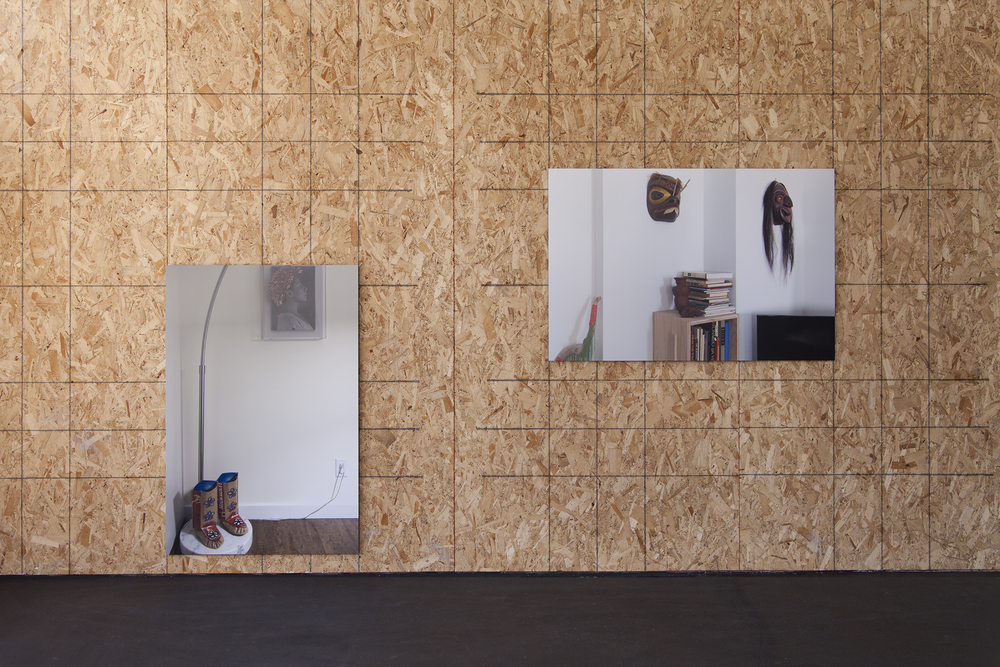 For an ongoing exchange project, Babak Golkar trades works with another artist; the other artist photographs his work in their collection, and Golkar does the same, forming a photographic diptych. Here is the diptych EX.027 (2016), the result of Golkar’s exchange with Anishinaabe artist Charlene Vickers, on view earlier this year at INCA in Seattle. Image courtesy the artists.
For an ongoing exchange project, Babak Golkar trades works with another artist; the other artist photographs his work in their collection, and Golkar does the same, forming a photographic diptych. Here is the diptych EX.027 (2016), the result of Golkar’s exchange with Anishinaabe artist Charlene Vickers, on view earlier this year at INCA in Seattle. Image courtesy the artists.
LS: You recently won a Davidoff Art Residency, to begin in January. What are you planning on doing during the residency—and otherwise, in the future?
BG: I’ve been jokingly saying I want to retire. I am so freaking tired. And this idea of retirement is really ridiculous in the creative industry—it comes with death, essentially. When you die, you are in retirement.
Anyway, one thing I have been doing and will keep doing is exchanging works with other artists in Canada. And we are not just exchanging works—the other artist takes a photo of my work in their collection and vice versa. What we end up with is a diptych photograph that is available for sale.
The other thing I’m thinking about is that I never learned how to paint—so I will be taking some courses. I am looking forward to that. I keep saying that I want to become a “Monday painter,” because that’s when the galleries are closed.
LS: Is there anything else you want people to know when encountering or thinking about your work right now?
BG: Not really. I’m not an exclusive person. I try to include as many layers to the works as possible so everyone can engage with them at certain levels. I’m happy whether they get engaged with something superficial, like thinking a fox with a silver tray is funny, or whether they want to dig in more and look at how that image engages with the failure of the banking system over the past 100 years.
At the risk of sounding really ridiculous and nationalistic—which I shouldn’t be, especially with my background—I also want to say we really have an amazing array of artists in Canada.
And part of my frustration, which drives me to build the collection-and-exchange project, is that we actually don’t have enough infrastructure for these artists. I mean, we have great infrastructure, but it’s not enough to support all the students who are going through our institutions and getting great training and artists who are doing really critical works. This country has amazing artists, and we don’t get to see them, we don’t get to know them. You kind of have to die to get noted. I’m not satisfied with that, and that’s why I am trying to design this project, so at least I can get to know their work a bit better.
Babak Golkar’s The Return Project is on view at Edel Assanti in London, England, until November 12, while his Time Capsules are on view at Sabrina Amrani in Madrid until October 28.
This interview has been edited and condensed.
Some clarifications were made to this article on October 5, 2016. For example, the person referred to previously as a First Nations carver is, more specifically, a First Nations souvenir carver. While Walmart and Ikea were the only two stores referred to previously, they are not the only ones accessed in The Return Project. Some more specificity around labour and the current London show was also added.

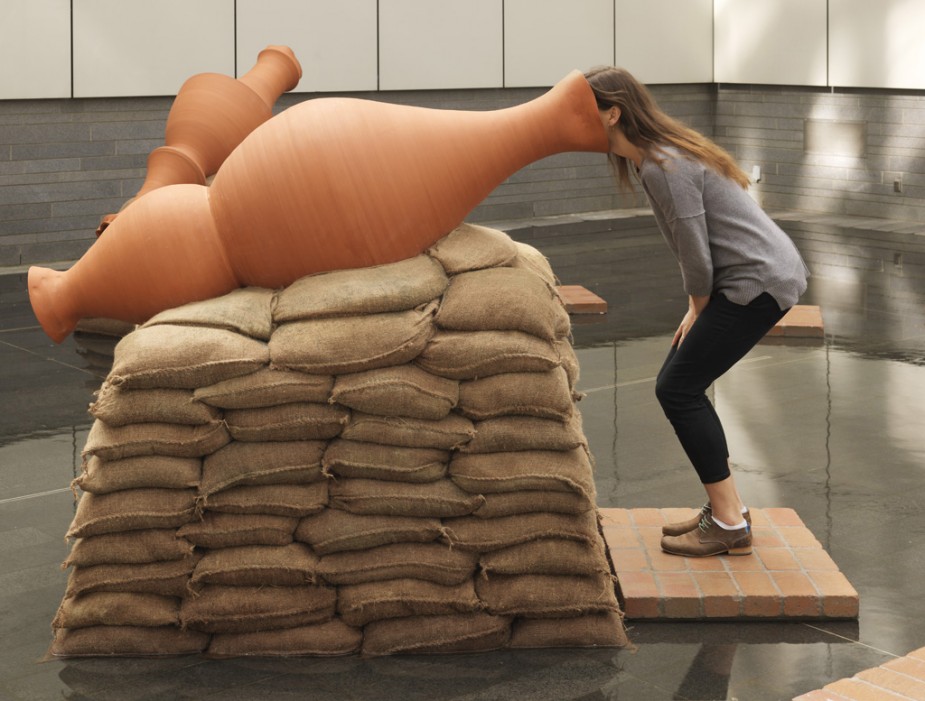 A visitor interacts with one of Babak Golkar's massive Scream Pots in the outdoor installation Time to Let Go organized by the Vancouver Art Gallery in 2014.
A visitor interacts with one of Babak Golkar's massive Scream Pots in the outdoor installation Time to Let Go organized by the Vancouver Art Gallery in 2014.







